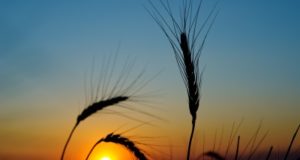|
Listen To The Article
|

If you’re lucky enough to live in the Midwest, your gardening challenges are few when compared to other regions. Most soil in the Midwest is loam or loamy clay, although the soils in Michigan are often black sand. Add some compost or manure every year, and you’ll have beautiful, fertile soils with little effort.
Cool, damp springs favor cool-season crops such as peas, lettuce, cabbage, and cauliflower. Potatoes are a favorite crop in the Midwest, as well. Long, hot summers are ideal for growing warm-season crops, including peppers, tomatoes, green beans, and of course, corn. No Midwest garden is complete without corn.
Summers in the Midwest are humid, but you will need to supplement rainfall with irrigation, particularly in hot weather. Use soaker hoses and drip systems rather than overhead sprinklers to conserve water and cut down on fungal diseases spread by wet leaves.
New Survival Seed Bank™ Lets You Plant A Full Acre Crisis Garden!
If you live in the northern Midwest, use heat-conserving measures to lengthen your growing season. Hoop tunnels and floating row covers allow you to grow greens earlier in the spring and later in the fall. Install black plastic mulch over the soil before planting tomatoes, melons, or peppers. Black plastic raises the soil temperature by ten degrees or more; it also conserves moisture and reduces weed growth. Try Wall-O-Water cloches for growing tomatoes, peppers, and summer squash. These devices act as mini-greenhouses and protect tender young plants from all but the harshest cold weather. Remove the cloches when temperatures rise above seventy-five degrees or you’ll burn your plants.
The cold winters of the Midwest help minimize insect and disease problems, but you may face a few challenges. Snails thrive in moist conditions, and you may also notice tomato worms, cut worms, and other leaf-chewing pests. Handpick and destroy these pests or rely on organic pest control methods such as Bacillus thuringiensis.
Your best offense against plant diseases is a good defense. Select disease-resistant varieties and plant crops so air can circulate freely between them. Remove and destroy any diseased plants and clean the garden completely in the fall. Rotate crops so plants grow in one place only every three years. Separate potatoes, tomatoes, and peppers, which carry the same diseases.
Weeds love the rich soil found in the Midwest just as much as vegetable crops. Plan to weed your garden at least once per week to keep weed growth under control. Once plants stand three inches tall, spread untreated grass clippings over the soil. Spread one inch of clippings per week so the clippings dry out between applications. Within a few weeks, you’ll have a mulch layer that is two to three inches deep. Grass clipping mulches not only reduce weed growth, but they also conserve moisture and add nitrogen to the soil.
Vegetable Varieties
Corn: When you think of agriculture in the Midwest, corn is probably one of the first crops that comes to mind. Drive through this region and you’ll find acres and acres of this staple crop. New varieties are bred for long-lasting sweetness, but heirloom varieties are often just as sweet, although the sugars turn to starch during storage. Select non-GMO varieties and plant corn in blocks of at least four rows. Corn is pollinated by the wind, so planting it in blocks ensures good pollination.
Tomatoes: The hot weather and long growing season found in the Midwest is ideal for growing tomatoes. Because disease problems are infrequent, you can grow heirloom varieties that lack disease resistance. Try a few old favorites like Brandywine, Cherokee Purple, or Zebra.
Beans: Green snap beans grow easily here, but you can also grow shell beans, which need a long growing season. Try kidney beans, navy beans, or turtle beans. The Midwest also grows more soybeans than any other part of the country.
Summer squash, cucumbers, and melons: All varieties of cucurbits thrive here. Plant these crops from seed in late spring or start seeds indoors in peat pots. Watch for squash borers, which tunnel into the stems and vines, causing the plants to eventually collapse.
Potatoes: Plant potatoes in early spring when the weather is cool and damp. Try planting red potatoes for an early summer crop and russet potatoes for fall harvests.
Broccoli and other brassicas: These crops thrive in moist, cool conditions. Plant them in early spring or late summer for a fall crop. If you have trouble with flea beetles, install floating row covers over the soil immediately after planting.
Leafy greens: Midwest summers are too hot for lettuce and other leafy greens, but spring is ideal. Plant several types of lettuce, along with kale and collards.
Perennial Food Crops
Orchard fruit: Apples grow well throughout most of the Midwest. Peaches, apricots, and cherries grow in the milder regions.
Berries: In Minnesota, Wisconsin, and Michigan, gardeners can grow blueberries, currants, gooseberries, and elderberries in addition to raspberries and strawberries. In warmer portions of the region, gardeners can grow blackberries as well.
Rhubarb: This old favorite needs full sun and slightly moist soil to thrive. A plant or two is usually plenty, and you’ll probably be giving divisions away after a few years.
Asparagus: Asparagus thrives in the cool springs and warm summers found in the Midwest. Plant it from one-year-old crowns in light, well-amended soil. Do not harvest spears for at least two years to allow the plants to develop strong root systems.